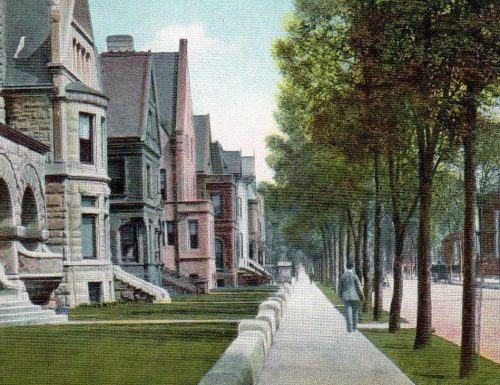By: Laurie Toth
When did going to dance schools become something people did? Actually, here in Chicago, earlier than I would have imagined. The very first dance school to open in Chicago was in 1835 by S. A. Marshall. Followed by James Martine’s School of Dance. Attending the Martine School of Dance was Mr. and Mrs. Augustus Bournique. These schools taught the complicated steps needed to perform the social dances of the day. The quadrille, gallop, schottische, to name just a few.

Photo Credit: Chicago History Museum
On September 24th, 1867 the Bournique’s opened their first school of dance on the southwest corner of Randolph and State with an opening party. Ironically, it was just across the street from where the Joffrey Ballet currently has its studios. They offered classes for children, women, and men separately. It appears Mrs. Bournique was the teacher during those early years. Later, Mr. Bournique appeared to take the lead in teaching classes. Four years later, the great Chicago fire destroyed everything the Bournique’s had worked so hard for.

Photo Credit: Chicago History Museum |

xxx |
By the fall of 1872, the Bourniques opened another studio. This time on the south side. 127 & 128 24th Street – between Indiana and Michigan Avenues. They offered two classes a week for children, one for women and two for gentlemen. Dancing classes were so popular a school was opened on the West side of town at 517-518 West Madison Street at the same time.

Photo Credit: Chicago History Museum
Eleven years later they opened their most magnificent dance studio yet. The south side school was located at 51 23rd Street, between Prairie and Calumet Avenues. Attention was placed not only on learning the proper dance steps; but also, on the importance of “gracefulness, courtliness of deportment and modest self-confidence”. The building was created in the Queen Anne style with Architect for this building being Burnham and Root. The large dance floor could accommodate 40 quadrille sets at one time! A very unique feature of the Ballroom was the balcony that surround it. It was 8 feet above the floor and was perfect for viewing the dancing below.

Photo Credit: Chicago History Museum |

xxx |
A rite of passage for all the elite children of Prairie Avenue and the Gold Coast was dancing lessons at Bourniques. Katherine Dexter McCormick grew up on Prairie Avenue and first met the man she was to marry years later at Bournique’s when she was just 13 years old. She remembered him as being “good looking, tall and a great dancer”. Later she was to discover that the 14-year-old Stanley McCormick was attracted to her as well. The Pullman twins’ letters of 1887 – 1888, written to their parents, are filled with stories of dancing at Bournique’s. Sanger Pullman writes to his father George Pullman on February 10, 1887: “A week from Saturday next, we have a dancing school reception and I think it will be very nice. I have a partner and so has George, engaged for the German. Mr. Bournique says that we may invite our parents, and so I have invited Mama and Aunt Mattie and wish you might be home so you could go too.”

Photo Credit: Chicago History Museum |

xxx |
Bournique’s began to rent out their space for parties and events. There became a need for spaces in which to have large dinner parties that could include dancing and bands. This became very popular for debutant, engagement, and parties that were just too large for even the largest home dining room. One newspaper article from 1888 described a Ball given by Mr. and Mrs. Cobb on Monday, December 14th. There were between 700 and 800 people invited. The Vallari’s Mandolin Band of 15 played in the Supper Room on the lower floor. The Hungarian Military Band, in full uniform, played the dance music. The actual dancing or “German” as they were called did not begin until 1:00 am and ended in the early hours of the morning. Some of those who attended were Mr. & Mrs. Robert Todd Lincoln, Mrs. Cyrus McCormick, Mr. & Mrs. William W. Kimball, Mr. & Mrs. Samuel Nickerson, Mr. & Mrs. Roland Nickerson, and Mr. & Mrs. John Glessner to name a few. A quote from Frances Glessner’s journal about the event:
“We went to Mrs. Walter Cobb’s ball at Bourniques. We left home at half past nine and were almost the first there. We came home at half past eleven”.
Apparently, they did not stay for the dancing.

Photo Credit: Chicago History Museum















